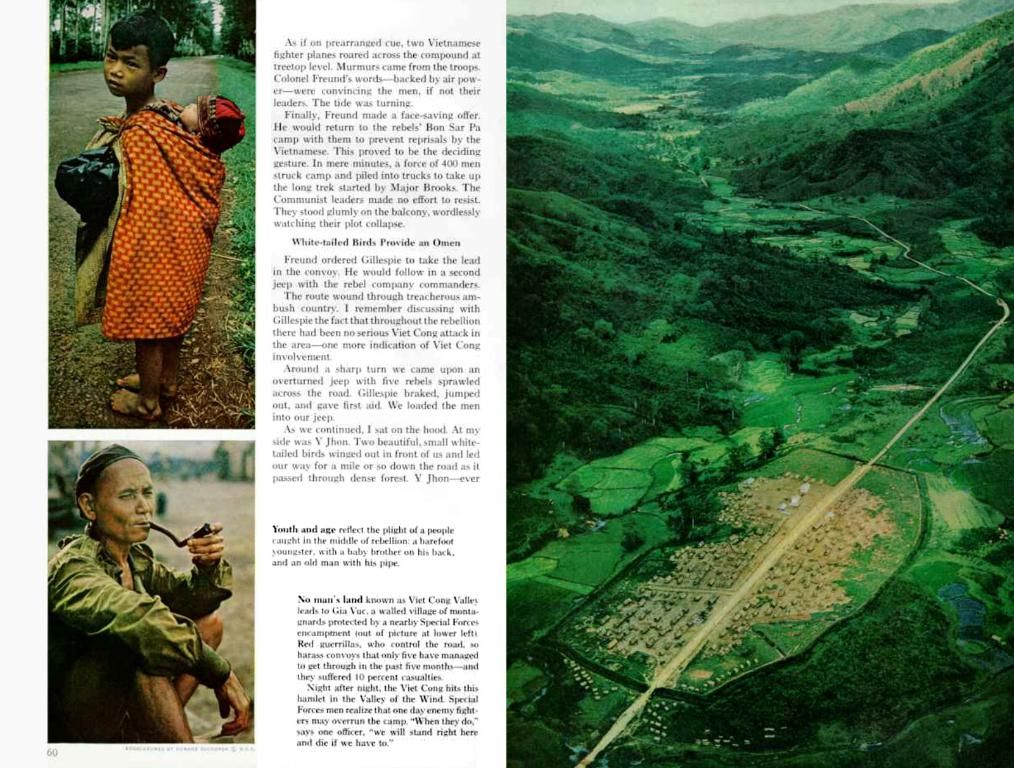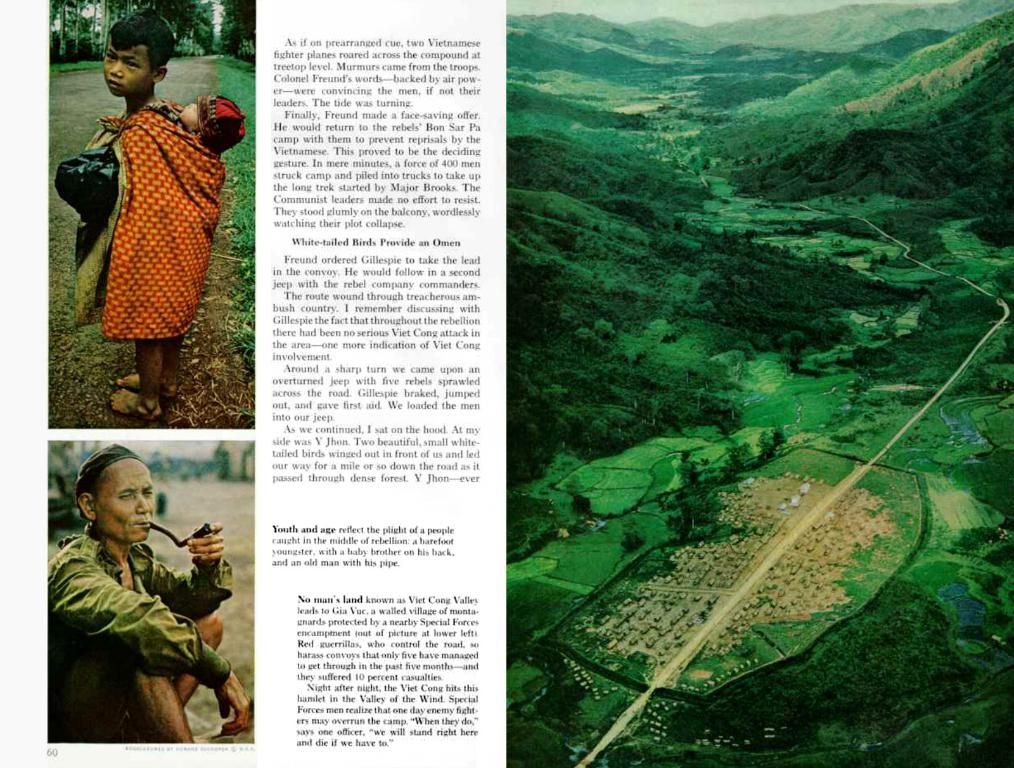Trump disrupts the area's agricultural resources or provisions
Title: Starved Out: Trump's Austerity Leaves Hungry Ghosts in Rural America
By: Lou Lou Locked
More Info Facebook Twitter WhatsApp Email Print Copy Link
With irons tightened and pockets lightened, Donald Trump's administration seeks to slash a billion dollars in social spending come March. The impoverished rural heartland, a far cry from the two coastline metropolises, is left reeling. In these untamed frontiers, local folks wage war on "food deserts."
On a regular basis, approximately 270 of Chesterhill's residents in the southeastern Ohio wilds gather in a communal hall to participate in an auction. Farmers, many classified as Amish, flaunt a tremendous variety of seasonal produce, including pumpkins, plums, bell peppers, corn, and apples. Stacks of goods tower and spill onto pallets. An open hall with a half-meter drop permits Amish farmers to unload their wares unencumbered by barriers.
Residents from the outlying areas assemble around the pallets, often bringing foldable seats for comfort during the auction. The auctioneer, stationed slightly elevated and amplified through a microphone, rapidly calls out the goods with a tough, almost indecipherable vernacular. As bids are placed and exchanged, money and goods trade hands on the spot. A folktale simple mechanism addressing a sizable problem. Chesterhill, cursed with the absence of a supermarket, compels those who strive for fresh produce to travel a bare thirty minutes.
One of the most consistent participants is local organization Rural Action. These crusaders distribute purchased food to food banks throughout neighboring counties, a win-win scenario that now stands on the precipice of a threatening setback. "The cessation of funding impacts farmers by diminishing the number of customers at the auction, which decreases prices due to declining demand," Molly Sowash, Rural Action's sustainable agriculture coordinator, confides to ntv.de in an interview.
Rural Ohio's "Food Deserts"
In these forsaken landscapes, local organizations serve vital roles. Based in the bucolic greenery of the Hocking Hills, Rural Action has dedicated its efforts since 1991 to enhancing the local food chain. Relatively densely populated Ohio is not immune to the scourge of "food deserts"—magnificent expanses where inhabitants must venture over an hour to reach a supermarket. This deplorable situation condemns countless individuals to lack access to wholesome, nutritious sustenance.
Traversing quaint, wood-encased towns, one occasionally encounters a Dollar General store, which caters to a range of commodities, including frozen foods, beverages, and cereal, but offers no fresh, unprocessed fare. In larger settlements, Walmart dominates the landscape. Admittedly, fresh food is available, but the profits generated emigrate from the state, further exacerbating the problems afflicting local poverty and depravity.
Rural Action's objective is the creation of a sustainable local food economy. The strategy revolves around directly connecting regional farmers with consumers, without the indecent dependence on intermediaries. In 2023, this idea burst forth as the "Farm to Food Pantry Project" (From Farm to Pantry). Local farmers supply their goods to small stores, food banks, and non-profit organizations in regions where supermarkets have been unable to establish themselves. Funding for this initiative originated from various US Department of Agriculture pots. "The funding was scheduled to continue until 2027, but the Trump administration unceremoniously halted it in March," Sowash reveals. "Farmers had already acquired seeds and equipment with the money to further advance the program. Customers were anticipating the harvest for the upcoming year."
Expert Opinion: The Demise of Dreams
Number of opioid prescriptions in Germany decreases
Many farmers face rough times due to the cease in funding, as the project was designed to function as cooperative aid. A staggering $6.6 million in public funds flowed into the project, but the economic output generated by the funding dwarfed this sum, a multiple, according to a report by the National Sustainable Agriculture Coalition on the impacts of the funding stop. The estimated revenue generated by the program is $28.6 million, as per Ohio Food Banks.***
The program has inspired countless youngsters to venture into farming and trade. Sixty percent of the project participants have been in operation for a maximum of ten years, according to data from Ohio Food Banks as of January 2025. Through funding, they were able to plan better and knew they would have customers for their basic produce in the coming years.***
"To hear that the project is being squashed is absolutely disheartening," laments Kara Olsen, a first-generation farmer. "Without this support in recent years, I would likely have had to shutter the farm." In many months, orders from Rural Action represented the sole source of steady income. "It takes a significant amount of time to build a loyal customer base. This program bridges that gap." She is not alone. According to a survey by Ohio Food Banks, 55 percent of participating businesses would face financial jeopardy without the support, and 68 percent would have to decrease their workforce to remain solvent.***
Not all is lost. Currently, Rural Action's staff are working ceaselessly to secure funding from private donors to keep as many participating businesses and farms operational as possible. In these embattled regions, the implications of losing these essential offerings are unforeseeable.
- USA
- Food Deserts
- Ohio
- Trump Administration
- Opioid Crisis
- Agriculture
- Poverty
- Local Economy
- Rural Community Support
- Business Closures
- The Trump administration's decision to cut a billion dollars from social spending in March threatens the sustainability of employment and community policies in rural areas, such as those addressed by Rural Action in Ohio.
- Finances play a crucial role in the implementation and success of initiatives like the Farm to Food Pantry Project, which aims to improve food-and-drink availability and support local businesses in Ohio's "food deserts."
- The cessation of funding for such programs not only affects employment opportunities but also impacts local lifestyles and general-news stories by contributing to increased poverty and business closures in rural communities.
- The impact of policy-and-legislation decisions, such as the funding cut for the Farm to Food Pantry Project, reaches deep into the fabric of rural America, influencing politics, food-and-drink accessibility, and the overall business landscape.







